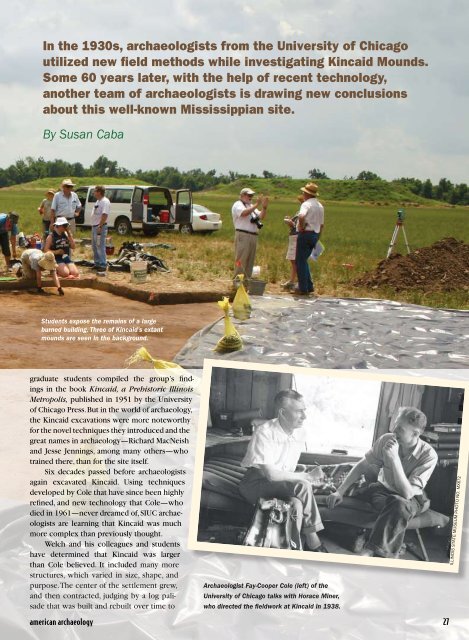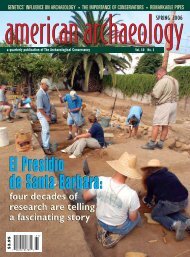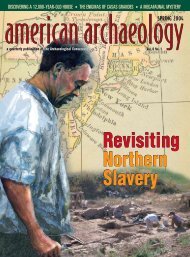Clovis Comet Debate - The Archaeological Conservancy
Clovis Comet Debate - The Archaeological Conservancy
Clovis Comet Debate - The Archaeological Conservancy
You also want an ePaper? Increase the reach of your titles
YUMPU automatically turns print PDFs into web optimized ePapers that Google loves.
In the 1930s, archaeologists from the University of Chicago<br />
utilized new field methods while investigating Kincaid Mounds.<br />
Some 60 years later, with the help of recent technology,<br />
another team of archaeologists is drawing new conclusions<br />
about this well-known Mississippian site.<br />
By Susan Caba<br />
Students expose the remains of a large<br />
burned building. Three of Kincaid’s extant<br />
mounds are seen in the background.<br />
graduate students compiled the group’s findings<br />
in the book Kincaid, a Prehistoric Illinois<br />
Metropolis, published in 1951 by the University<br />
of Chicago Press. But in the world of archaeology,<br />
the Kincaid excavations were more noteworthy<br />
for the novel techniques they introduced and the<br />
great names in archaeology—Richard MacNeish<br />
and Jesse Jennings, among many others—who<br />
trained there, than for the site itself.<br />
Six decades passed before archaeologists<br />
again excavated Kincaid. Using techniques<br />
developed by Cole that have since been highly<br />
refined, and new technology that Cole—who<br />
died in 1961—never dreamed of, SIUC archaeologists<br />
are learning that Kincaid was much<br />
more complex than previously thought.<br />
Welch and his colleagues and students<br />
have determined that Kincaid was larger<br />
than Cole believed. It included many more<br />
structures, which varied in size, shape, and<br />
purpose. <strong>The</strong> center of the settlement grew,<br />
and then contracted, judging by a log palisade<br />
that was built and rebuilt over time to<br />
Archaeologist Fay-Cooper Cole (left) of the<br />
University of Chicago talks with Horace Miner,<br />
who directed the fieldwork at Kincaid in 1938.<br />
american archaeology 27<br />
illinoiS STaTe mUSeUm pHoTo no. mx672




